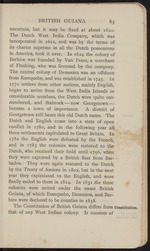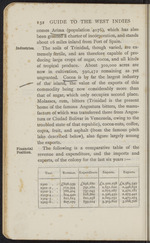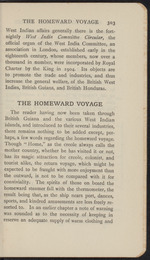| 1 |
 |
“...BRITISH GUIANA 83
uncertain, but it may be fixed at about 1620.
The Dutch West India Company, which was
incorporated in 1621, and was by the terms of
its charter supreme in all the Dutch possessions
in America, took it over. In 1624 the colony of
Berbice was founded by Van Peere, a merchant
of Flushing, who was licensed by the company.
The central colony of Demerara was an offshoot
from Essequebo, and was established in 1745. In
1770 settlers from other nations, mainly English,
began to arrive from the West India Islands in
considerable numbers, the Dutch were quite out-
numbered, and Stabroek — now Georgetown —
became a town of importance. A district of
Georgetown still bears this old Dutch name. The
Dutch and English came into a state of open
conflict in 1780, and in the following year all.
three settlements capitulated to Great Britain. In
1782 the English were defeated by the French,
and in 1783 the colonies were restored to the
Dutch, who retained their hold until 1796, when
they were...”
|
|
| 2 |
 |
“...Industries.
Financial
Position.
132 GUIDE TO THE WEST INDIES
comes Arima (population 4076), which has also
been grantêfl 4 charter of incorporation, and stands
about 16 miles inland from Port of Spain.
The soils of Trinidad, though varied, are ex-
tremely fertile, and are therefore capable of pro-
ducing large crops of sugar, cocoa, and all kinds
of tropical produce. About 300,000 acres are
now in cultivation, 590,472 remaining as yet
ungranted. Cocoa is by far the largest industry
of the island, thlT value of the exports of this
commodity being now considerably more than
that of sugar, which only occupies second place.
Molasses, rum, bitters (Trinidad is the present
home of the famous Angostura bitters, the manu-
facture of which was transferred there from Angos-
tura or Ciudad Bolivar in Venezuela, owing to the
troubled state of that republic), cocoa-nuts, coffee,
copra, fruit, and asphalt (from the famous pitch
lake described below), also figure largely among
the exports.
The following...”
|
|
| 3 |
 |
“...THE HOMEWARD VOYAGE
303
West Indian affairs generally there is the fort-
nightly West India Committee Circular, the
official organ of the West India Committee, an
association in London, established early in the
eighteenth century, whose members, now over a
thousand in number, were incorporated by Royal
Charter by the King in 1904. Its objects are
to promote the trade and industries, and thus
increase the general welfare, of the British West
Indies, British Guiana, and British Honduras.
THE HOMEWARD VOYAGE
The reader having now been taken through
British Guiana and the various West Indian
islands, and introduced to their several industries,
there remains nothing to be added except, per-
haps, a few words regarding the homeward voyage.
Though “ Home,” as the creole always calls the
mother country, whether he has visited it or not,
has its magic attraction for creole, colonist, and
tourist alike, the return voyage, which might be
expected to be fraught with more enjoyment than
the outward...”
|
|
